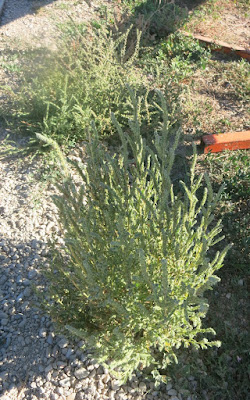 |
| ragweed, Ambrosia |
And it is.
The ragweeds, the genus Ambrosia, in the sunflower family, Asteraceae, are all endemic to the Americas. Of the 22 species native to North America, only five are widespread (see USDA maps). But two species are in every one of the lower 48 states, annual ragweed Artemisia artemisifolia, and western ragweed, Artemisia psilostachya. They look very similar. The annual ragweed has always been a plant of disturbed areas, spending the winter as seeds, needing relatively open conditions to prosper during its one year of life. Human disturbances have given it many more places to grow. The other widespread ragweed, western ragweed, is a perennial, and is found in native ecosystems all across the United States.
In a project done in undisturbed tallgrass prairie in Kansas a few years ago, the only plant found in every plot, each about one square yard, was western ragweed. Across the continent, it is a similarly important component of native plant communities (link).
 |
| Green flowers all over this ragweed plant. |
Ragweeds are native, they are common...and yet everyone hates them.
The hate is well-founded if you are allergic to ragweed pollen. Pollen from ragweed has distinctive chemistry to which people easily become sensitive. And those very common ragweed plants mate by lofting lots and lots of pollen into the air so that some comes down on the stigmas of another flower, leading to pollination and seed formation. It is hard to avoid breathing in ragweed pollen if you are outdoors in North America in late summer.
 |
| rageweed plant |
 |
| ragweed in full bloom |
Ragweed allergies are common and often awful, but not universal. Native Americans reportedly were not allergic to ragweed. Perhaps they were genetically resistant, perhaps their exposure from childhood protected them. Many modern Native Americans have ragweed allergies but a lot has changed since first contact. And allergies are irregularly distributed among Americans of European, Asian and African ancestry. It is hard to know what causes having versus lacking allergies to ragweed.
 |
| Ragweed plants |
The USDA Plants website calls western ragweed Cuman ragweed. Apparently that comes from Ambrosia cumanensis which may--or may not--be the same as Ambrosia psilostachya. You may recognize that cumanensis means, "from Cumaná" which is a province in nothern Venezuela. Almost everyone else calls Ambrosia psilostachya western ragweed.
Which brings me to the puzzle of the scientific name, Ambrosia, the genus of ragweeds. A quick google shows you that ambrosia means "the food of the gods," something heavenly to experience. Ragweed? The botanical sources available to me agree the genus name means food of the gods but add "allusion unknown." Nobody knows why the ragweeds were given this particular name. They were named by Linnaeus in Sweden in the middle 1700s. Often Linnaeus gave plants the names they had in colloquial Greek or Latin. The ragweeds are American so that wasn't an option. For new plants, sometimes he recycled the colloquial name of a somewhat similar plant. For example, silphium was the Roman name of a Mediterranean-region plant that was overharvested to extinction (see recent BBC article link). Linneaus used Silphium as the scientific name of a group of sunflower relatives of central North America, for example compass plant link, creating substantial confusion. My Latin dictionary lists ambrosia as meaning, in addition to food of the gods, a food for the horses of the gods and an ointment that conferred immortality. None of these enlighten me as to why Linnaeus chose the name Ambrosia for ragweeds. I imagine Linnaeus sitting at his table considering a pressed, dried specimen of a ragweed that looked something like this (A click will magnify it. Specimen collected in 1884 in "North America" now in Harvard's Arnold Arboretum Herbarium). He would have had little information about it other than that it was from eastern North America and maybe that Indians there used it to prevent blood poisoning or to stop bleeding. Not knowing anything about its ability to induce allergies, he gave it an uplifting name. Why such a particularly nice name? No one knows. (Insight into this puzzle welcome!)
Ragweeds have been introduced to Europe and are causing allergies there. Europeans can certainly dislike the plant as both an exotic and a source of allergy!
Even though they are found in most habitats across North America, ragweeds are rarely serious threats to crops or other human endeavors. If they didn't cause allergies, they'd be nondescript common native plants.
References
Bishop, L. T. Treating Seasonal Allergies the Old School Indian Way. Revisited. LastRealIndians.com link
Kathy Keeler, A Wandering Botanist
More at awanderingbotanist.com
Join me on Facebook: https://www.facebook.com/AWanderingBotanist
My latest book tells stories about conspicuous wild plants NoCo Notables: 15 Northern Colorado Plants Worth Knowing Available at Amazon link
You might also like these blog posts:
Buffalo grass link
Miner's candle link

Dandelions link

My latest book tells stories about conspicuous wild plants NoCo Notables: 15 Northern Colorado Plants Worth Knowing Available at Amazon link
You might also like these blog posts:
Buffalo grass link
Miner's candle link

Dandelions link




I've pondered the same thing--why ambrosia and found this bit of linguistics today: ... The scientific name of this genus is sometimes claimed to be derived from the Ancient Greek term for the perfumed nourishment of the gods, ambrosia (ἀμβροσία), which would be ironic since the genus is best known for one fact: its pollen produces severe and widespread allergies. However, the generic name is actually cognate with the name of the divine dish, both being derived from ambrotos (άμβροτος), "immortal." In the case of the plants, this aptly refers to their tenaciousness, which makes it hard to rid an area of them if they occur as invasive weeds.
ReplyDeleteThat's wonderful! Thank you very much.
Delete